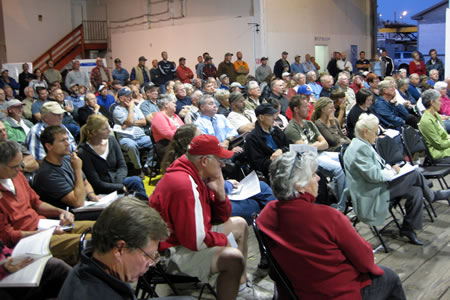
Representatives of NOAA Fisheries Service got an earful from dozens of sport fishermen and whale watch operators over proposed new regulations designed to keep boats further away from Orcas than is current allowed.
More than 150 people filled the Port's Warehouse Thursday night and, in effect, told the NOAA representatives 'no' to the proposed regulations which would require boaters to stay at least 200 yards from Orcas. The regulations would include a half-mile wide no-go zone along the west side of San Juan Island from May 1 to Sept. 30.
Most of the crowd seemed to sport fishermen, charter operators, whale watch operators and kayak tour leaders. Complaints ranged from "you've got a huge gap in your data," to "the Orcas aren't impacted by fishing boats now."
One sport fisherman said "You only wee whales about one-third of the time in that no-go zone. If you'd come to us, we would have given you data."
Boat owner Larry Carpenter said "Orcas choose to be around fishing boats. If they were bothered, they'd just swim away. I don't believe that excluding sport fisherman would help killer whales."
Charter operator Jay Field, in an interview, said "These rules are completely unnecessary. Whales don't avoid our boats. The west side of San Juan Island is the best salmon fishing area nearby."
Whale watch operator Shane Aggergaard said he thought the current state law, which requires boats to stay 100 yards from Orcas, was satisfactory. "Forcing boats to stay more than one-half mile from San Juan Island will damage the whale watch industry." He added, "The economic cost will be far greater than just the whale watch industry."
In fact, the Anacortes Chamber of Commerce prepared a statement which said said "Put simply, whale watching is a substantial economic driver in Skagit County, which we estimate generates at least $7.2 million annually," adding, "we believe this figure to be conservative—the “no go” zone under consideration would have a negative impact on various other industries—fishing, kayaking, and charter boat operations--that is not quantified here."
Not everyone at the meeting was opposed to the new rules, though. Evergreen Island leader Tom Glade said "We support any regulation that will help protect the Orcas." He pointed out that there are only 85 Orcas in existence, about half the number of people that showed up for the NOAA meeting.
At one point in the meeting, the crowd all but took control, insisting on continuing a question-and-answer portion instead of moving on to giving testimony that NOAA was prepared to video record.
NOAA representative Lynn Barre started off the meeting saying that their studies show that when boats are nearby, Orcas increase surface activity, change swimming patterns and decrease time foraging." Since Orcas are on the endangered list, NOAA is justified in implementing protections. Barre said studies show that Orcas have an 88-100% increase in communication calls, indicating interference from outside noises.
During a break in the meeting, NOAA representative Donna Darm said she had taken a whale watch cruise this summer out of Anacortes and that other people on the boat were excited to see the whales, even though they were 330 yards away, indicating the 200 yard rule would not hinder whale watch tours.
In addition to a no-go zone, NOAA's proposal would prohibit vessels, including kayaks, from approaching within 200 yards of a killer whale — an increase of 100 yards — and from getting within 400 yards of the forward path of any killer whale. Government and research vessels, fishing boats and ships traveling in approved shipping lanes would be exempt from distance regulations. Tribal fisheries would be exempt from the no-go zone because of treaties between their governments and the United States.
NOAA is tasked with developing and implementing a recovery plan for the Southern Residents, which were listed as endangered under federal law in 2005.
They will also get feedback at a meeting in Friday Harbor on Oct. 5.
